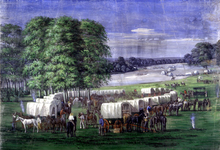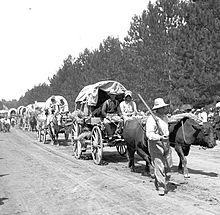Wagon train: Difference between revisions
m Reverted edits by 92.43.66.7 to last revision by 208.81.184.4 (HG) |
No edit summary |
||
| Line 2: | Line 2: | ||
[[Image:Pioneers Crossing the Plains of Nebraska by C.C.A. Christensen.png|right|thumbnail|Pioneers Crossing the Plains of Nebraska]] |
[[Image:Pioneers Crossing the Plains of Nebraska by C.C.A. Christensen.png|right|thumbnail|Pioneers Crossing the Plains of Nebraska]] |
||
[[Image:WagonTrn.jpg|thumb|1912 re-enactment of a pioneer wagon train in [[Utah]] ]] |
[[Image:WagonTrn.jpg|thumb|1912 re-enactment of a pioneer wagon train in [[Utah]] ]] |
||
A '''wagon |
A '''wagon traiiiiin''' is a group of wagons traveling together. In the [[American Old West|American West]], individuals traveling across the plains in [[covered wagon]]s banded together for mutual assistance. Although most trains elected a captain and created by-laws, in reality the captain had little authority. His role was largely confined to getting everyone moving in the morning and selecting when and where to camp at night. |
||
Overland emigrants discovered that smaller groups of twenty to forty wagons were more manageable than larger ones. Membership in wagon trains was generally fluid and wagons frequently joined or left trains depending on the needs and wishes of their owners. An accident or illness, for instance, might force someone to fall behind and wait for the next train, or an emigrant might "whip up" to overtake a forward train after a quarrel. |
Overland emigrants discovered that smaller groups of twenty to forty wagons were more manageable than larger ones. Membership in wagon trains was generally fluid and wagons frequently joined or left trains depending on the needs and wishes of their owners. An accident or illness, for instance, might force someone to fall behind and wait for the next train, or an emigrant might "whip up" to overtake a forward train after a quarrel. |
||
Revision as of 15:17, 13 November 2009


A wagon traiiiiin is a group of wagons traveling together. In the American West, individuals traveling across the plains in covered wagons banded together for mutual assistance. Although most trains elected a captain and created by-laws, in reality the captain had little authority. His role was largely confined to getting everyone moving in the morning and selecting when and where to camp at night.
Overland emigrants discovered that smaller groups of twenty to forty wagons were more manageable than larger ones. Membership in wagon trains was generally fluid and wagons frequently joined or left trains depending on the needs and wishes of their owners. An accident or illness, for instance, might force someone to fall behind and wait for the next train, or an emigrant might "whip up" to overtake a forward train after a quarrel.
Although "train" suggests a line of wagons, when the terrain permitted the wagons would often fan out and travel abreast to minimize the amount of dust each wagon encountered.
At night, wagon trains were often formed into a circle (a "laager") for shelter from wind or weather and corral the emigrants' animals in the center to prevent them from running away or being stolen by Native Americans. While Native Americans might attempt to raid horses under cover of darkness, they rarely attacked a train; wagons were seldom circled defensively, contrary to popular belief.
Although wagon trains are associated with the Old West, the Trekboers of South Africa also traveled in caravans of covered wagons. Today, covered wagon trains are used to give an authentic experience for those desiring to explore the West as it was in the days of the pioneers and other groups traveling before modern vehicles were invented.
See also
References
- Stewart, George R. The California Trail: An Epic With Many Heroes. New York: McGraw-Hill, 1962.
- Unruh, John D., Jr. The Plains Across: The Overland Emigrants and the Trans-Mississippi West, 1840-60. Urbana: University of Illinois Press, 1993.
- Van der Loeff, A. Rutgers. Children on the Oregon Trail
External links
![]() Media related to Covered wagons at Wikimedia Commons
Media related to Covered wagons at Wikimedia Commons
